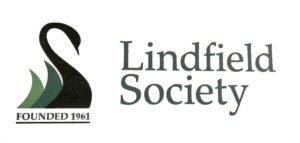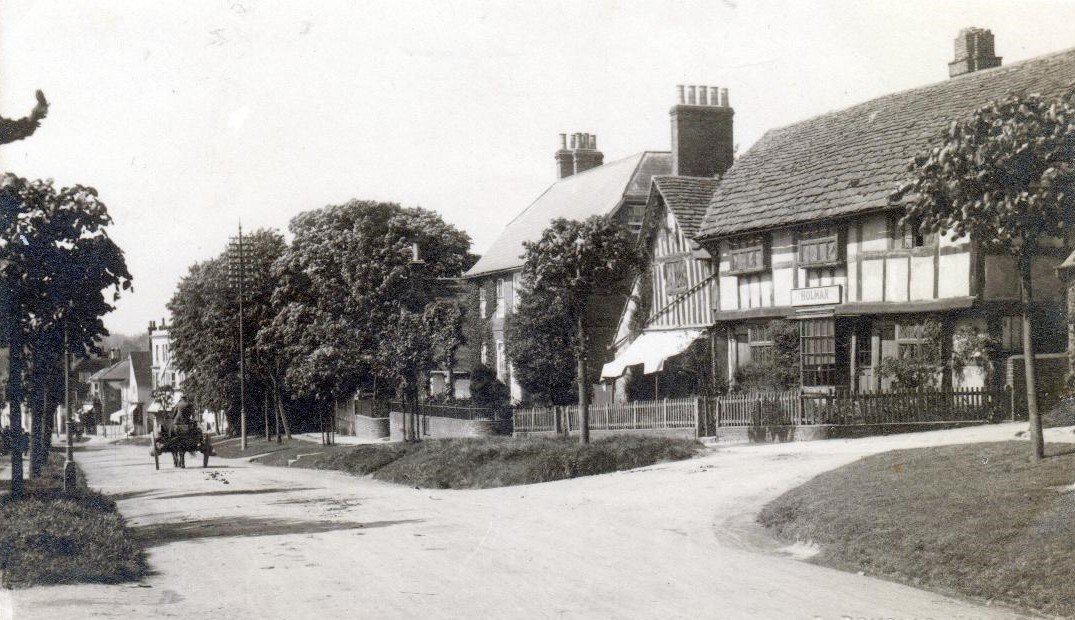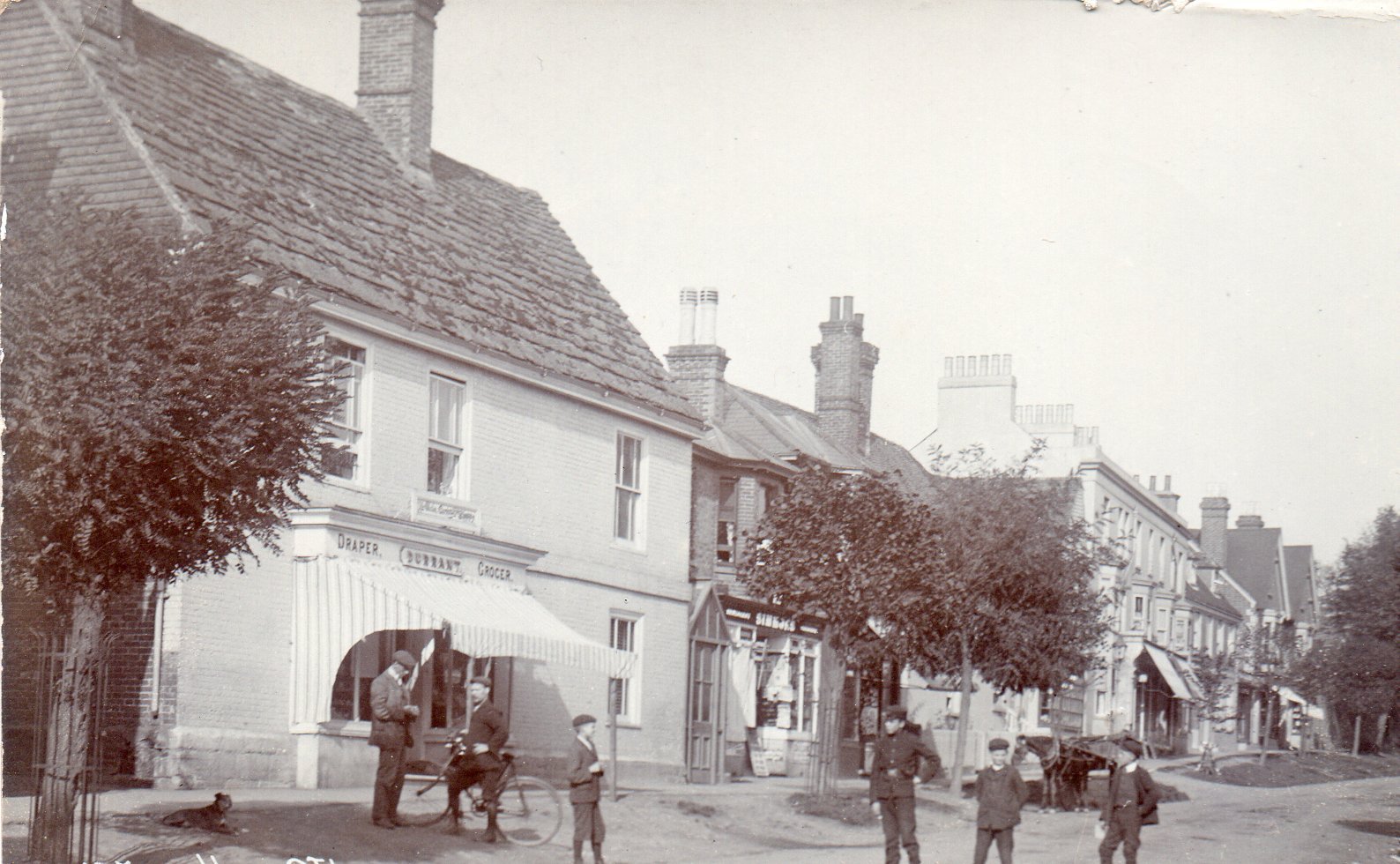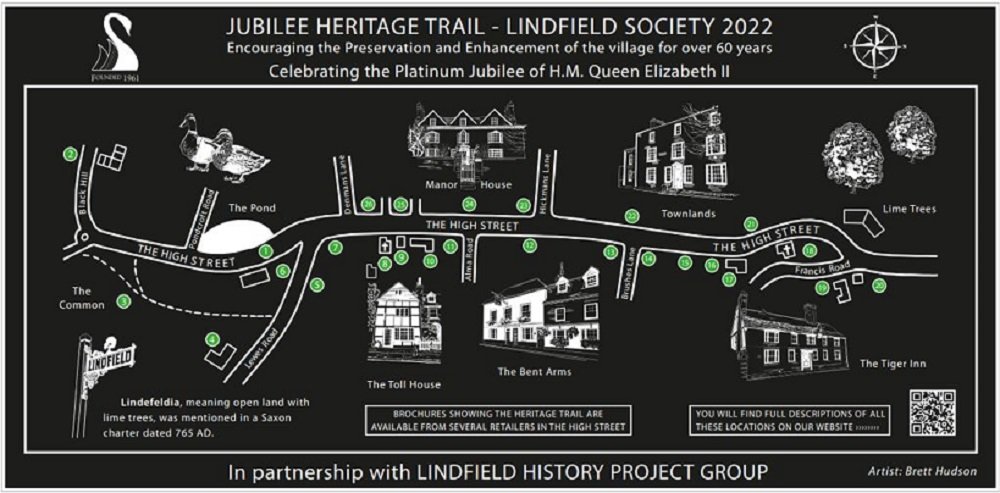
A brief history
Built along an ancient route, Lindfield’s name is derived from Old English Lindefeldia, meaning open land with lime trees, first mentioned in a Saxon charter dated 765AD. In the charter King Ealdwulf grants parcels of land from Stanmer to Crawley Down, to support the building of a church. Lindfield grew into a small thriving medieval town, supporting the local agricultural economy, with businesses from bonnet makers to blacksmiths. Neighbouring Haywards Heath comprised only a few scattered farmsteads until the railway arrived in 1841.
Forty one medieval (pre 1550) and post medieval timber framed houses survive in the village.
Start at the map located at the front of King Edward Hall.
1 The Pond & King Edward Hall

![HT. Pond Durrant20190705_11371681[7302]](https://lindfieldsociety.org.uk/wp-content/uploads/2022/02/HT.-Pond-Durrant20190705_113716817302-scaled.jpg)
Walk towards the Common and continue up Black Hill.
(If you would like a slightly shorter walk, go onto the Common and take the footpath beside the old brick wall and continue with no.3.)
LINDFIELD is often defined by its Pond, as very few High Streets have a large expanse of water abutting the street. In years past it was a part of the Common. Both were owned by the Lord of the Manor. The houses around the pond date mainly from the 1850s. Formed naturally it was a watering spot for cattle grazing on the Common, passing horses and animals being driven to new pastures or market. During WW2 soldiers washed army lorries and armoured vehicles in the pond.
King Edward Hall was designed by Walter Tower with a hint of neo-Tudor style and built by Norman and Burt of Burgess Hill. The village hall with club rooms above opened in 1911 and has been at the centre of village social life and entertainment for over a century.
Following the start of the Great War, in November 1914 it became a Red Cross Auxiliary Hospital for the convalescence of wounded soldiers. Initially with 20 beds, later increased to 26 beds, it had cared for 877 patients by the war’s end.
![HT.Martin garage KEH0335[7303]](https://lindfieldsociety.org.uk/wp-content/uploads/2022/02/HT.Martin-garage-KEH03357303.jpg)
2 Pelham Place Cottages

The cottages are all that remain of the Lindfield School of Industry, and are believed to be the training workshops. Founded in 1825 by William Allen, a Quaker philanthropist, chemist and social reformer, who believed education was one route out of poverty for children from the labouring classes. The school provided a sound basic education and vocational training for boys, girls and infants.
On William Allen’s death in 1843, the school transferred to the non-conformist British and Foreign School Society and later became the cornerstone of Lindfield School.
William Allen was also concerned about poverty amongst agricultural labourers and as a social experiment he established a rural colony for 18 agricultural workers to the east of the village, in the America Lane area. Each cottage had land for them to work in their own time to produce an income and reduce reliance on poor relief. The experiment did not prove to provide a viable solution.
Return to the mini-roundabout and take the path across the common, passing the horse trough erected to commemorate George V’s coronation.
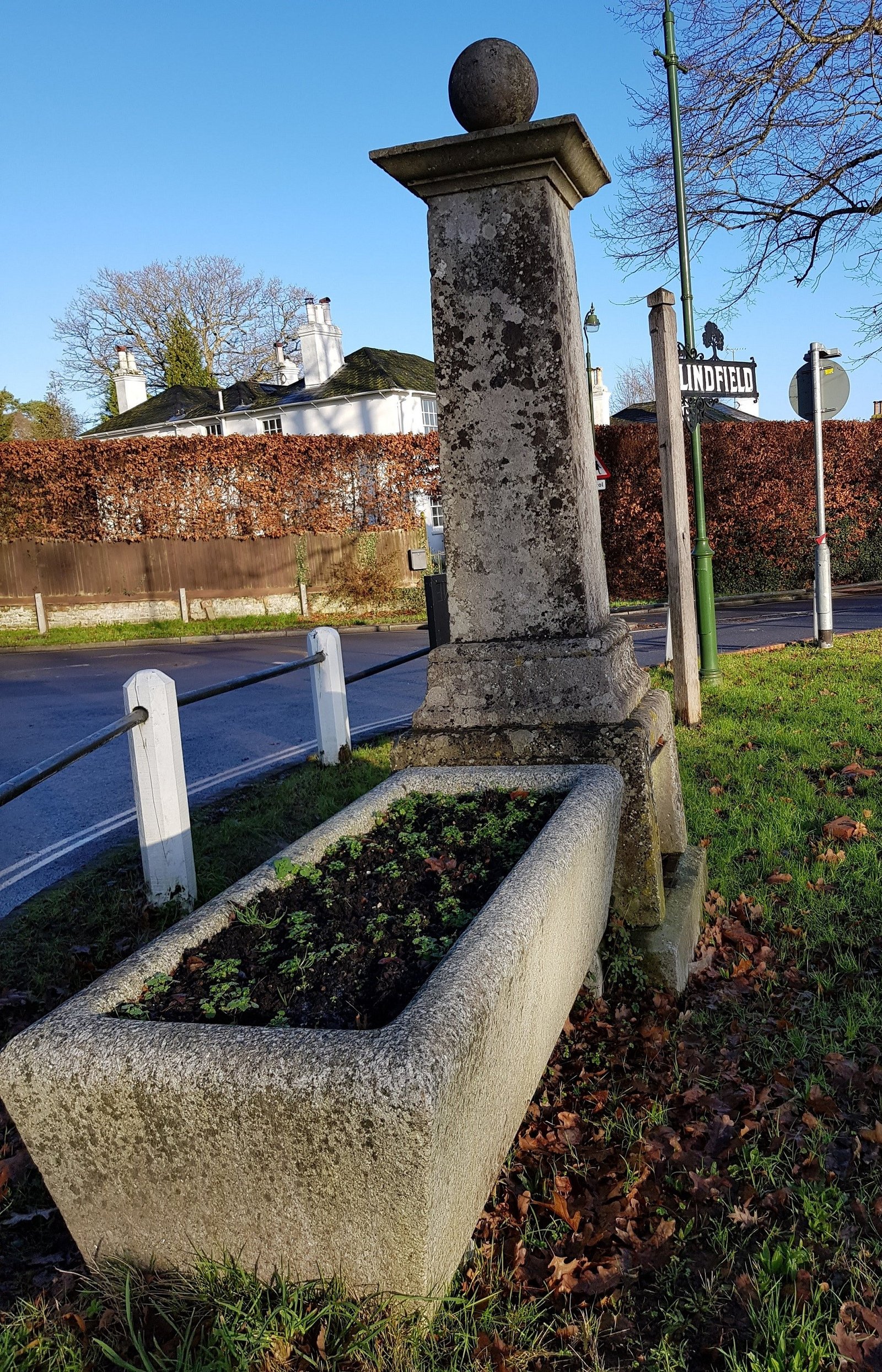
3 The Common

Over the centuries The Common has been used by villagers for many purposes from grazing cattle to commemorative events, to sport, with cricket having been played since 1747. A notable use was as the site for Lindfield Fair during the 19th century and well into the next. Throughout most of the fair’s long existence it provided entertainment but was primarily a sheep and livestock sale, with thousands of animals being sold; latterly it was solely an entertainment event.
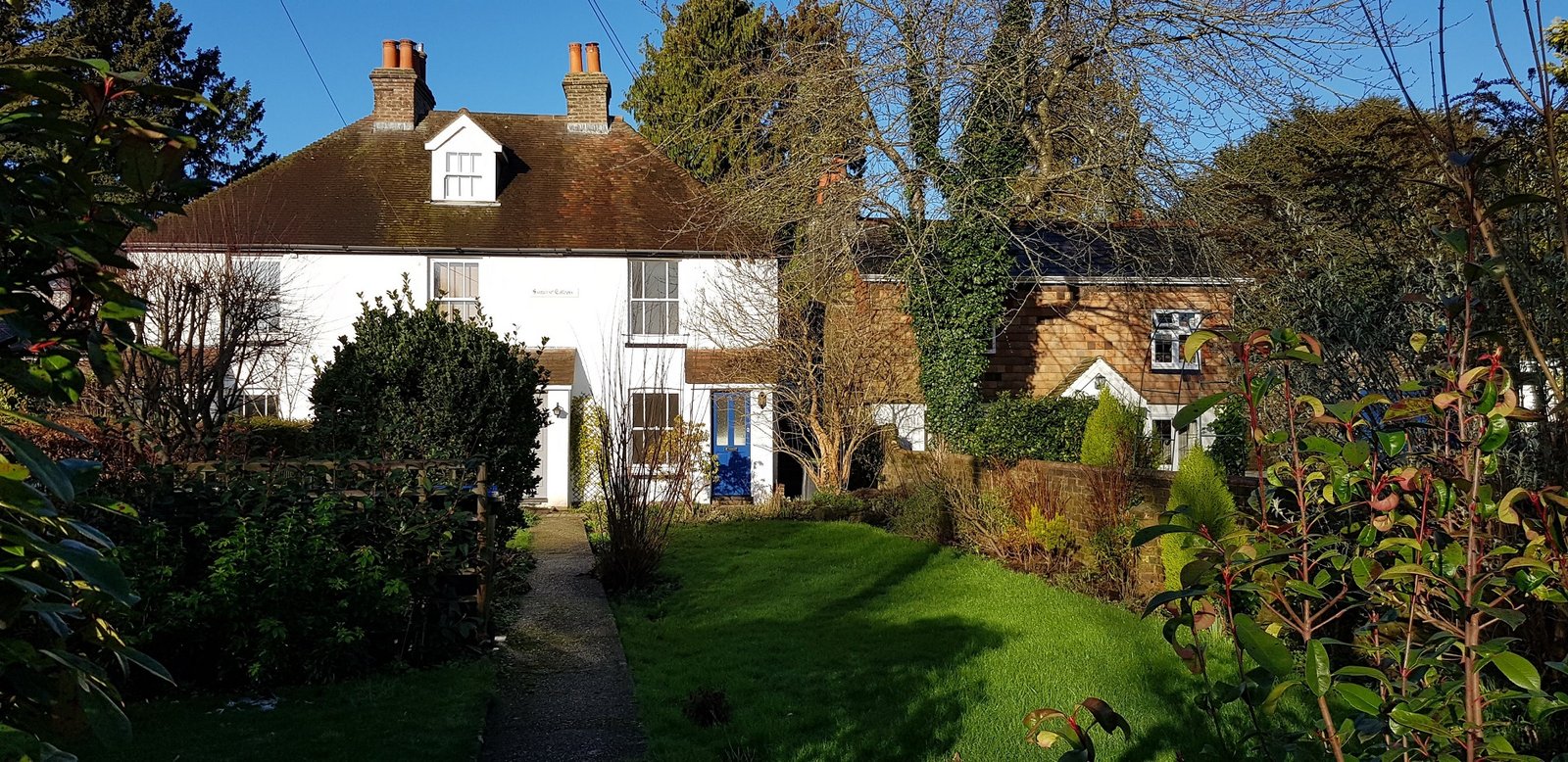
On reaching the children’s playground, proceed down the path on the left, with the playground on your right. Pass several pretty cottages and on reaching Lewes Road go to the right.
4 Lindfield School

Following educational reforms the Lindfield School Board was established in 1881 and took control of the non-conformist British School on Black Hill. This provided the foundation for the Lindfield Board School. With an increasing school roll a new school urgently needed to be built and this opened in 1883, on part of the Common. The fine red brick Victorian building with its large windows reflected all aspects of good school design. It is pleasingly embellished with a Dutch style gable end and finials.
The school finally moved to new facilities in 2000 and the Victorian buildings are now private houses.
Cross Lewes Road turn left and over Chaloner Road.
5 Carriers

Originally built as a four bay open hall in the early 1300s, it is now regarded as the oldest and most complete medieval house in Lindfield. A bay is the space between two pairs of principal upright posts in the timber frame. Medieval open hall houses are so called as the hall, the main room, occupying the middle section did not have a floor above so was open to the roof. This allowed smoke from the central fire hearth on the floor to rise and drift out through the roof. On both sides of the hall there was a room with a floored chamber or store room above.
Around the 1600s an additional bay and chimney stack was added to the east end. The brick and tile exterior has replaced the wattle and daub.
During the early part of the 20th century it was three dwellings, and in the 1930s they were condemned. The historic house was saved from demolition after being listed as emergency wartime housing.
Continue along Lewes Road towards the High Street.
6 Old Fire Station
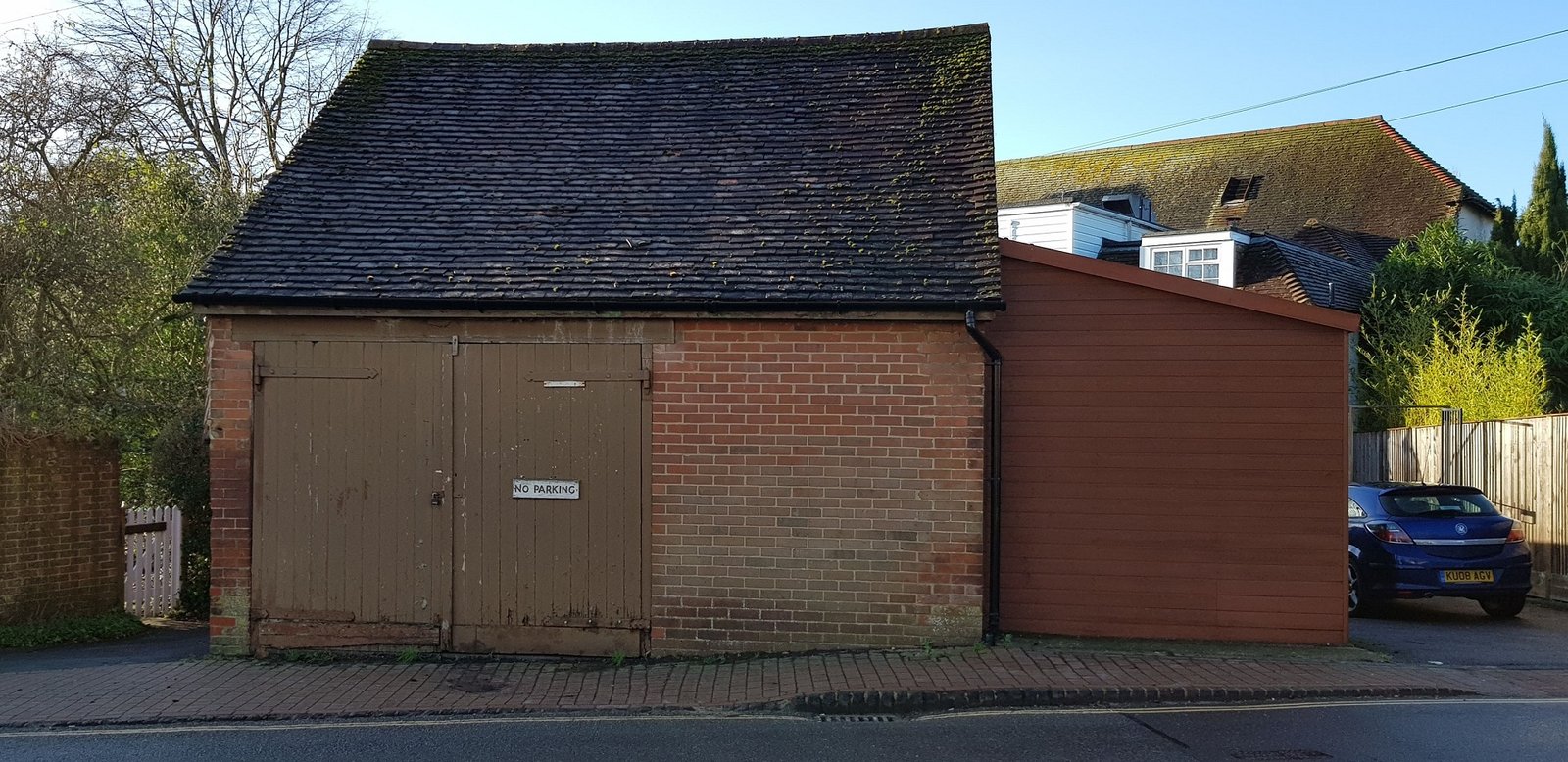
On the opposite side of Lewes Road, the small single storey brick building was the Lindfield Fire station. The Parish Council established the Lindfield Fire Brigade in 1899 with basic equipment. Ten years later a Merryweather Greenwich Gem horse drawn steam fire pump was acquired at a total cost of £276-15s-0d. To house their proud new fire engine the Council secured a lease on the redundant former stable of Pear Tree House.
The building served as the village fire station until the Brigade was disbanded in 1934. On the outbreak of World War 2 the building was used by the Lindfield Auxiliary Fire Service.
Continue towards the High Street and turn right
7 Bank Cottages 36 & 38 High Street
The cottages are a good example of houses hiding their true age. External appearance suggests a build date in the 1700s, but in fact they were built in the very early 1400s as a Wealden style four bay open hall house. This was a popular style for higher status houses from c1380 for the next hundred years. A good example of an original Wealden house is Thatched Cottage which will be seen at the top of the High Street.
Head north up the High Street.

8United Reformed Church
In common with communities across Sussex, Lindfield had a strong non-conformist following, with prayer meetings being held at various properties in the village. A non-conformist chapel was opened on this site on Good Friday 1813, but soon became too small. It was demolished and replaced in 1858 by the present building in the neo-gothic style with an emphasis on height. The Congregational Chapel became the United Reformed Church in 1972.

9 Toll House
The aptly named Toll House, built in about 1630, became a toll cottage on the turnpike road from New Chapel, near East Grinstead, to Brighton in 1803. There was a toll gate across the High Street at this point. Another gate was at the entrance to Hickmans Lane, so it was not possible to journey south or north through the village without paying a toll. The gates were removed on 31 October 1884 and burnt in the High Street on Bonfire Night.
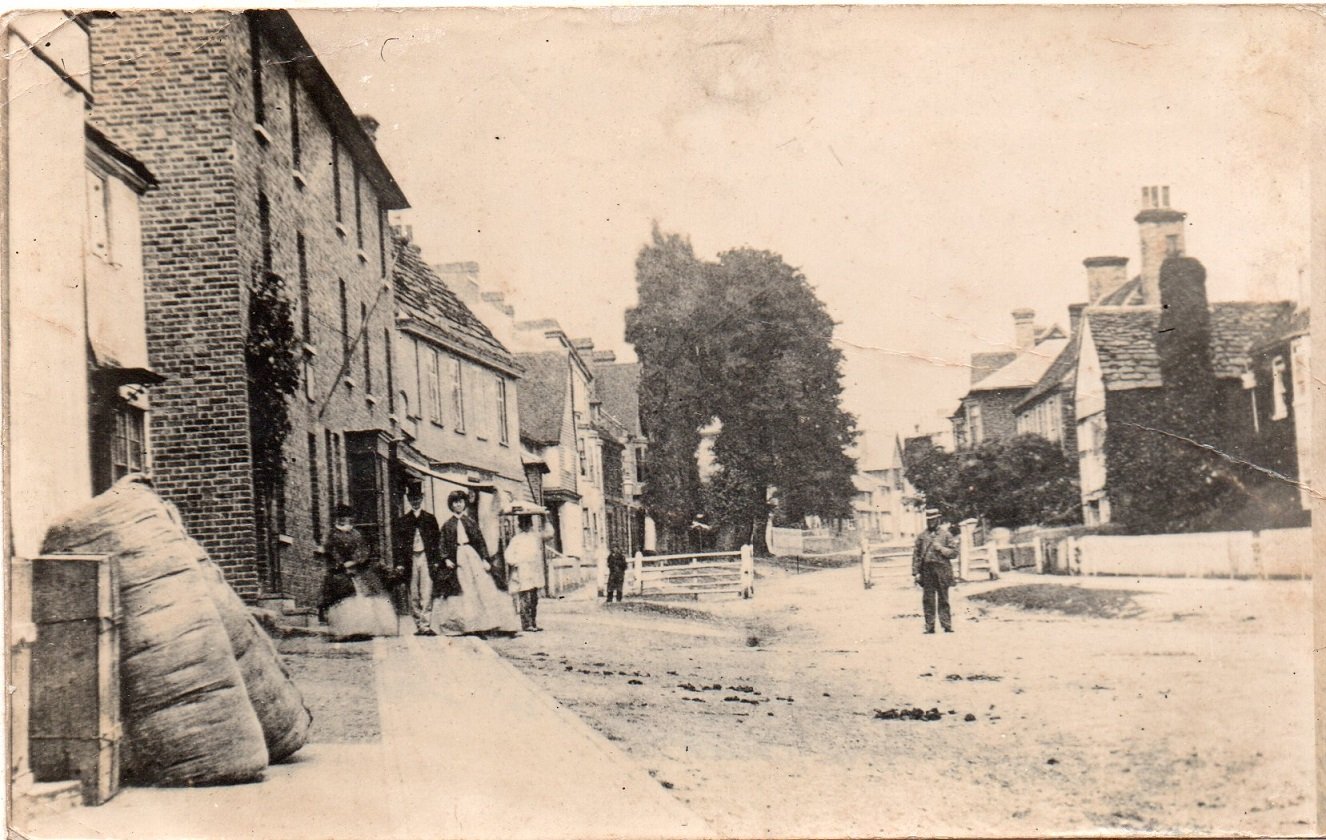


10 The Red Lion
The Red Lion was established around 1747 as an ale house lower down the High Street at Ryecroft, next to the United Reformed Church. Early inn signs often reflected the crest of the owner of the property. Land in the area of Ryecroft was owned by the Russell family and their emblem was a rampant red lion. In 1804, the sign of the Red Lion moved up the High Street to Porters, and 30 years later to its present location.
The Mills family took over the newly located Inn and during their time they produced Lindfield Sauce, a fermented sauce similar to Lea & Perrins Worcester Sauce. Invented by Charles Mills and, according to the bottle label was served at George IV’s coronation banquet. The sauce had quite a following with Wilkie Collins, the famous Victorian author, regularly ordering half a dozen bottles as did other London gentlemen.
Continue up the High Street.
11 Mid High Street: East Side
Pass a short row of shops built c.1850 named Albert Terrace, and unsurprisingly the terrace across the street is Victoria Terrace.
After crossing Alma Road, the High Street becomes residential, whereas in years past the properties were both residential and workplaces for artisans and shopkeepers. The houses differ in age and style creating a pleasing streetscape.
Last century Boarsland c.1650, was Charman’s Bakery with a bake house to the rear and a shop extension in the front garden. A little further along is Crosskeys a medieval open hall house. The chimney stack was added in the late 16th century and the cross wing at the northern end was also an addition to the original build. A less attractive addition was a single storey extension from house to pavement, which a century ago served as a fish shop.
Although differing in appearance Crosskeys, Malling Cottage and adjoining Priory Cottage have a history similar to Crosskeys. The cottages were originally built as an open hall house in the late 1400s. Likewise a chimney stack was added to the building, probably around 1600; and last century a single storey shop extension at the front.



12 Malling Priory
Built in c.1730 for Peter Short and his wife Philadelphia Short, daughter of the wealthy local Burrell family. Unusually for a Georgian house the front windows are not symmetrical and the doorway with tall pediment is not centrally placed.
Malling Priory despite its name has no religious nor manorial connections. It is a recent addition as the house has been previously known as Cheaters, Taylors, Lindfield House and Ivy House when the front was completely covered with ivy.

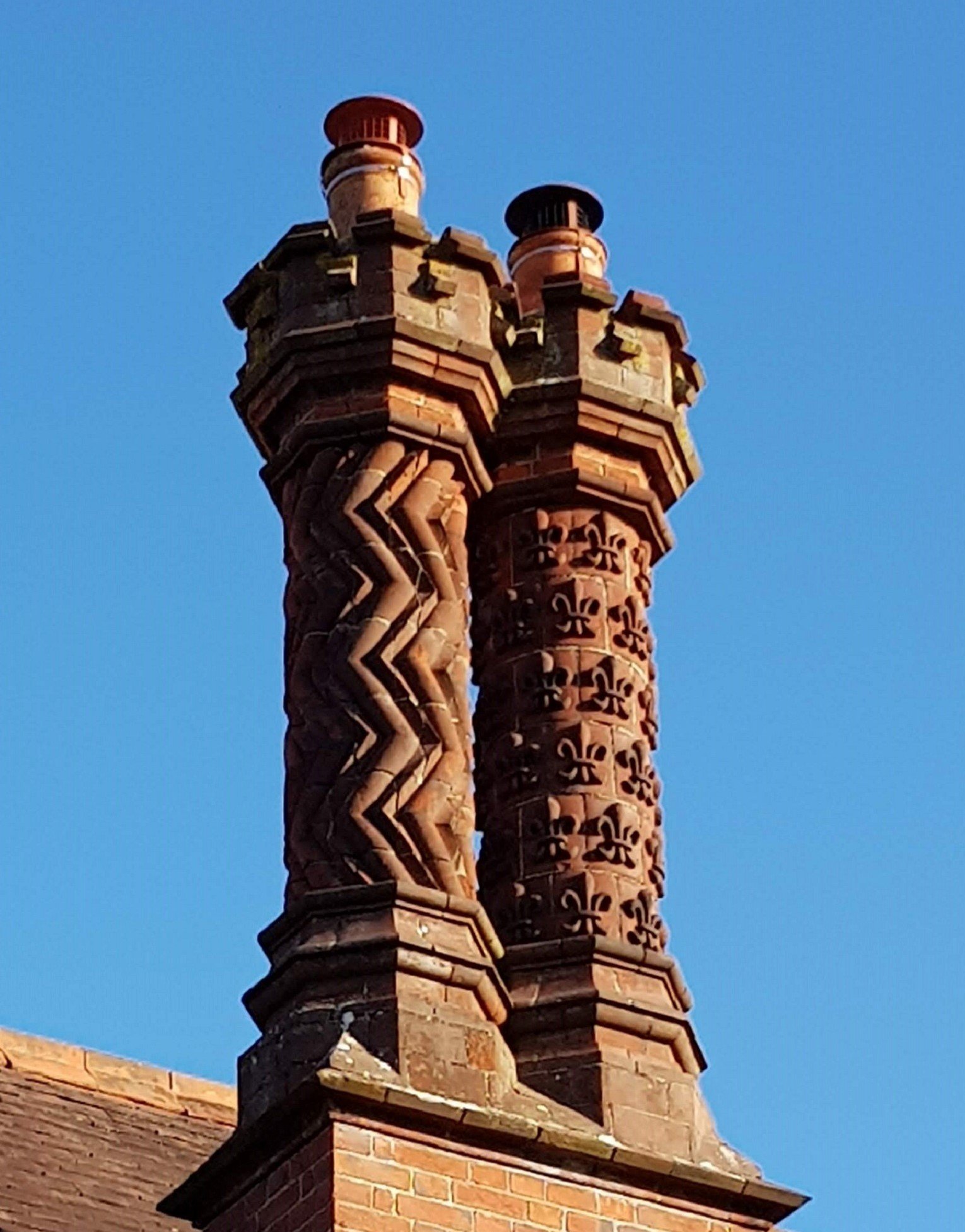
As you walk past the pair of large semi-detached houses, built in 1886 and used during the Great War as an army hospital, look up at the impressive chimney pots.
13 Bent Arms
An alehouse has existed on this site since at least 1660 and probably appreciably earlier. In 1682 it acquired a wine licence becoming the White Lion Inn; an ermine lion featured on the Newton’s family crest, who for a time were the Lords of the Manor. The main part of the building can be traced to this time.
An Assembly Room was added in 1785 creating the main entertainment and social venue for the village for the next 100 years.
During the late 1820s the White Lion was acquired by John Bent. Before arriving in Lindfield he had been involved with a mining company in Ireland, the Member of Parliament for Sligo and Totnes. Previously he had been a Commissioner in Demerara, a British Colony, and owned Plantation Vrouw Anna in British Guiana, which held many enslaved Africans.
In 1839, the London to Brighton stage coach ‘The Accommodation’ left the Bent for Brighton at 3.30 pm every Tuesday, Thursday and Saturday.
Julius Guy, a coach builder, had his premises at the Bent. In 1886 he patented the addition of rubber blocks to the springs for horse-drawn coaches. This greatly improved their ride. This improvement won a gold medal at an international exhibition in 1888 and was used by the British and Dutch royal families and many members of nobility.

After crossing Brushes Lane you arrive at Spongs
14 Spongs
In the 1920s Spongs was the schoolboy home of Group Captain Frank Carey CBE, DFC and 2 Bars, AFC, DFM, US Silver Star. Born in 1912 he joined the RAF as an apprentice, aged 15, and was selected for pilot training in 1935. So began an illustrious and adventurous flying career.
In May 1940, at the time of Dunkirk, he was shot down and slightly wounded over France. Following a dangerous and arduous journey ending near Nante, an abandoned aircraft was stolen to fly across the Channel.
On one mission during the Battle of Britain his Hurricane was badly damaged crash landing near Pulborough, Sussex. After recovering from his injuries he was posted to Burma, and many perilous sorties against the Japanese followed. The continuing Japanese advance forced the RAF to retreat. Frank Carey was then posted to form a Fighter Defence Unit turning the main street through Calcutta into a fighter runway. Carey claimed he could get from restaurant table to airborne in 4 minutes!
By the War’s end, Carey was credited with 25 ‘kills’ and 3 shared, the second highest scoring Hurricane pilot. He was considered by his contemporaries to be one of the finest fighter pilots of WW2.

15 Pilstye and Pierpoint House
Pilstye was built in about 1600 and with its surviving brew house or workshop to the side is a good example of an early post medieval house. In the 17th and 18th century Pilstye was a butchers with a slaughterhouse at the rear.
Neighbouring Pierpoint House dates from about 1650 and was originally the site of two cottages and a mercer’s shop. The house name reflects Matthew Pierpoint, a surgeon, who purchased the property in 1765 and it remained in the ownership of the family for 100 years.
It is one of many houses in the High Street to feature in the ‘Big Rebuild’ when medieval houses were replaced with houses that reflected developments in building and design.
Pause by the archway entrance to a passage to view Bower House on the other side of the High Street.
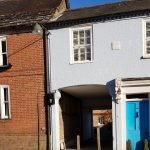


16 Bower House
Bower House is one of the three oldest surviving in Lindfield with a build date before 1350. Constructed as a five bay open hall house and, as indicated on the façade, it was restored in the 16th century and re-fronted in 1725. The date stone dated 1725 with the letters VAM refers to the owner Alexander Usborne and Mary his wife. The tile hung frontage was added in the 19th century.
From around 1742, Dr. John Dutton leased the property; he was the appointed doctor to the poor of Lindfield. Dr. Dutton began conducting experimental smallpox inoculations and kept the inoculated persons in the house to see if smallpox developed. This caused great consternation among inhabitants. As a consequence, Dr. Dutton was required to stop this practice and enter into a £600 bond for 60 years, payable should he recommence inoculations. It was at this time he established the Pest House in Gravelye Lane, Lindfield, for smallpox sufferers.

17 Tiger Inn
The former Tiger Inn, standing at the churchyard entrance, was originally an open hall house built around 1400. It may have been the parish guest and alehouse. Subsequently it became the home of the Michelbourne family. They were a family of merchant adventurers who had a tiger on their crest. When the family moved away from the village during the 1500s the house became an inn called the Michelbourne Arms, later changing its name to Tiger Inn.
The building has been much extended throughout its life and was regularly used for many parish and commercial events such as auctions. The Tiger Inn closed in 1916 and was purchased for £700 raised by subscription from parishioners, becoming All Saints Church House.
Enter the churchyard.
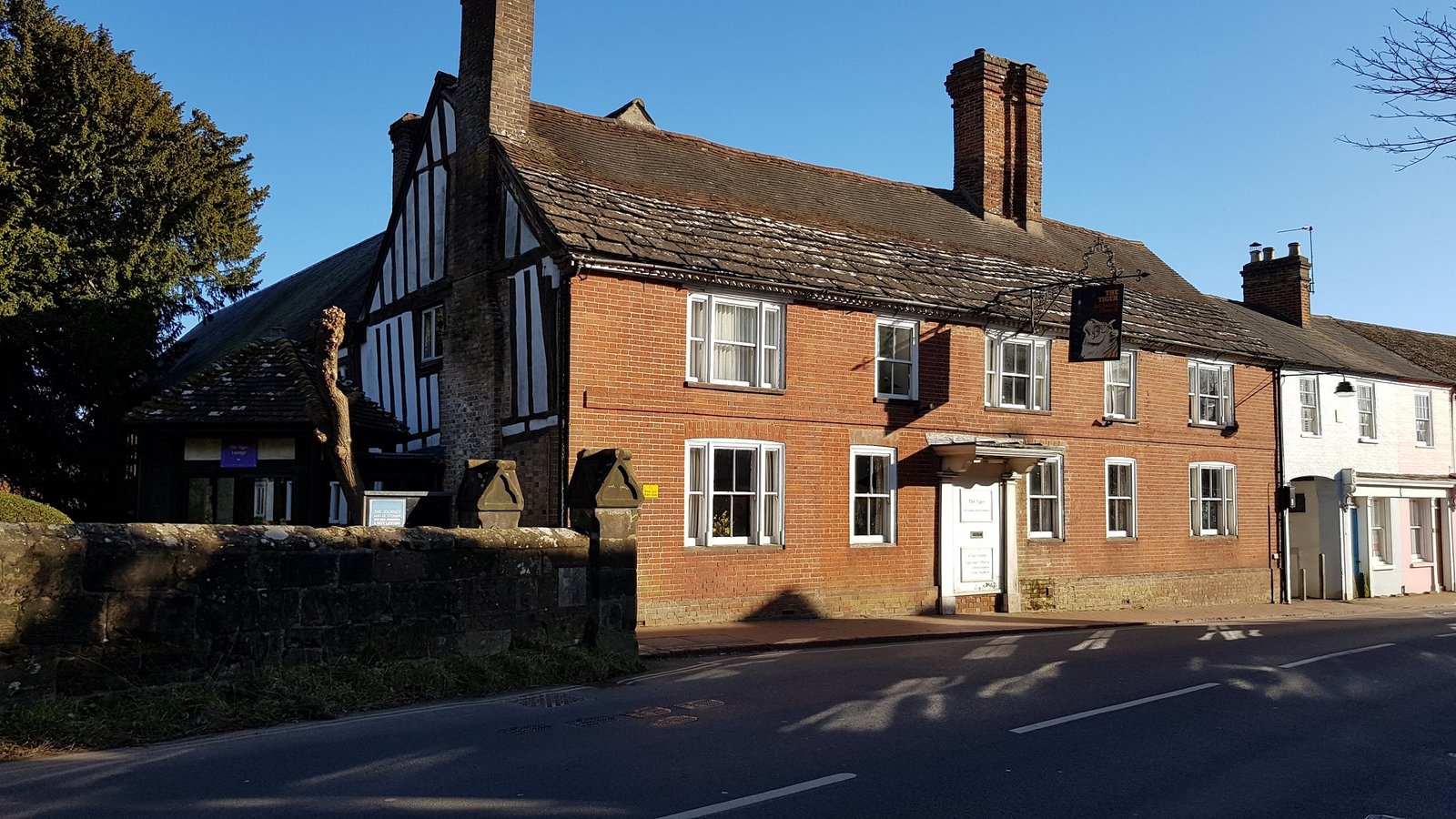
18 All Saints Church
Close to the entrance the Village War Memorial commemorates the fallen of both World Wars. Designed by the famous ‘gothic revivalist’ church architect Sir Ninian Comper and made in Clipsham stone from Rutland. At the head facing west, is the Calvary with the figures of Christ Crucified, John, his favourite Disciple and Mary Magdalene. Upon the reverse is the figure of the Virgin Mary with baby Jesus.
At the base, inscribed into the wall are the 61 names of the fallen in the Great War. Below are named the 34 men killed during WW2.
Look up at the church clock, made by Gillets of Croydon, it was originally in a building at Cawnpore, India. When the building was demolished, after the Indian Mutiny of 1857-58, to make way for a memorial tower, the clock was returned to England and installed in the tower’s south face.
An older method of telling the time is just visible in the form of two mass dials (sun dial) on the buttresses either side of the door arch. The right hand mass dial can be seen inscribed into the third stone block above the base stones. The other is at a similar height but has almost disappeared.
All Saints Church is believed to be the site of the church mentioned in the Saxon charter of 765AD. The current parish church built in Wealden sandstone dates from the 13th-15th centuries. The architectural style is English perpendicular style as exemplified by large tall windows and flowing stone tracery. The north and south transepts give the church a cruciform footprint.
By 1840 the church was in disrepair and following his arrival, the Reverend Francis Sewell instigated a restoration with Victorian improver’s zeal much advocated at the time, destroying many historic features. Further restoration to the building’s fabric was required three decades later.
Friar Tuck, an outlaw featured in Robin Hood stories, was a priest at the church in the 1400s. Royal writs dated 1417 were issued for the arrest of ‘Frere Tuck’ who led a band of criminals committing poaching, murder, robberies and arson in the border areas of Sussex and Surrey. A further writ, issued in 1429, stated that Friar Tuck was the alias of Robert Stafford, a priest at Lindfield. Robert Stafford was never arrested and there is no record of his death. He became immortalised in the Robin Hood fables; the first surviving written record of Friar Tuck appearing is in ‘Robin Hood and the Sheriff of Nottingham’ in 1475.
Follow the churchyard path to the east end of the church.
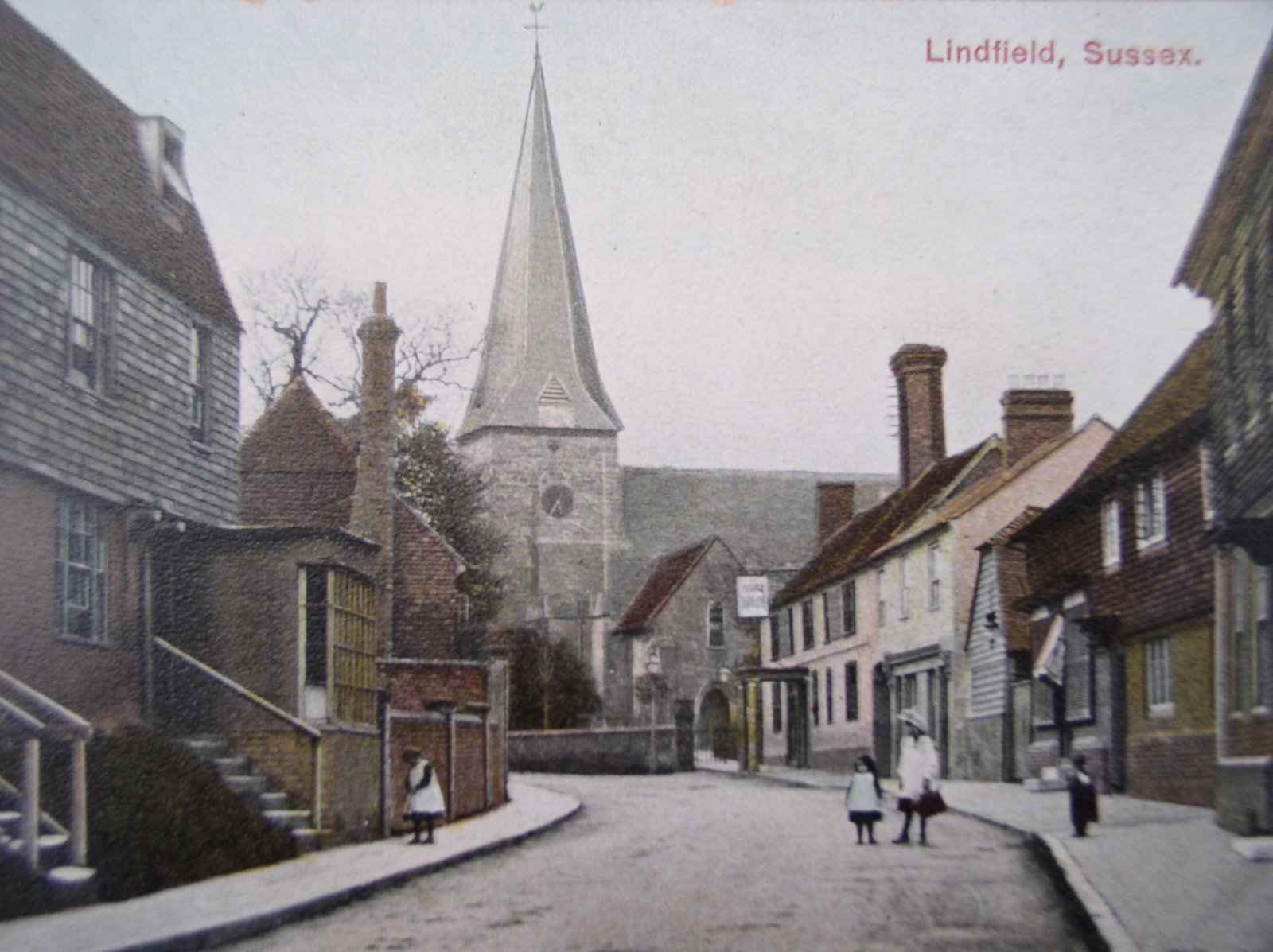

19 Old Place
Opposite is the Old Place Estate once the country residence of Charles Eamer Kempe, a renowned Victorian stained glass artist. It comprised his grand house, a ‘garden house’, formal gardens, a wilderness garden and about 100 acres of parkland. He was a member of the long standing and prominent Sussex Kemp family that developed Kemp Town, Brighton and sold to the Prince Regent the farmhouse that became the Royal Pavilion, Brighton.
Walk a short way to your right to observe a rather strange looking structure with towers and bell turret; this was the garden house used primarily for pleasure and entertaining as was the main house.
Return back along the road, passing a fine Tudor house built in 1584 by the Chaloner family as their manor house. This is the original Old Place today known as West Wing. In 1793-4 it became the village poor house for destitute Lindfield inhabitants until about 1837. The poor house had a school room and weaving shop for flax and wool.
Kempe purchased Old Place in 1875, restoring the house and using it as the start point for his grand residence completed in 1895. At the time of his purchase the Lane ran right past the front door. This did not please Kempe so he obtained permission to move the Lane to its present position and enabled the garden seen today to be created.
His grand residence featured in Country Life magazine describing its lavish interior as a ‘Palace of Art’. Unfortunately, the extent of Kempe’s extended Old Place is not very visible from the road, but will be glimpsed a little further on after crossing the High Street.
Please note there is no public access to Old Place.
Re-join the High Street and turn right.
20 Thatched Cottage
Thatched Cottage, built in 1390, is a Wealden style open hall house, a design popular for high status houses in the Wealden areas of Kent and Sussex between c.1380 and 1500. This places Thatched Cottage as an early example surviving in original form.
Like the standard open hall house, the central section did not have a first floor and was flanked by floored rooms at each end. The distinctive feature is that the upper levels of the floored ends are jettied – overhang the ground floor giving extra floor space. This arrangement requires additional support for the roof provided by curved braces. These can be clearly seen on Thatched Cottage.
When chimneys were installed and a first floor built over the hall of Wealden houses, they often had their jettied ends built under and the hall wall brought forward. These changes removed the identifying external features as evidenced by Bank Cottage seen at the bottom of the High Street and six others ‘hidden’ in the village.
Continue a short distance up the High Street, carefully crossing the road outside Lindfield House (c1725).
Turn to your left and take a few paces.
Look across the road to see the extent of Kempe’s grand house. Look along the roofline to the restored Belvedere, an open-sided viewing gallery, constructed in 1891, with nine gold-plated flags and a weather vane. To the right is an impressive set of chimneys.
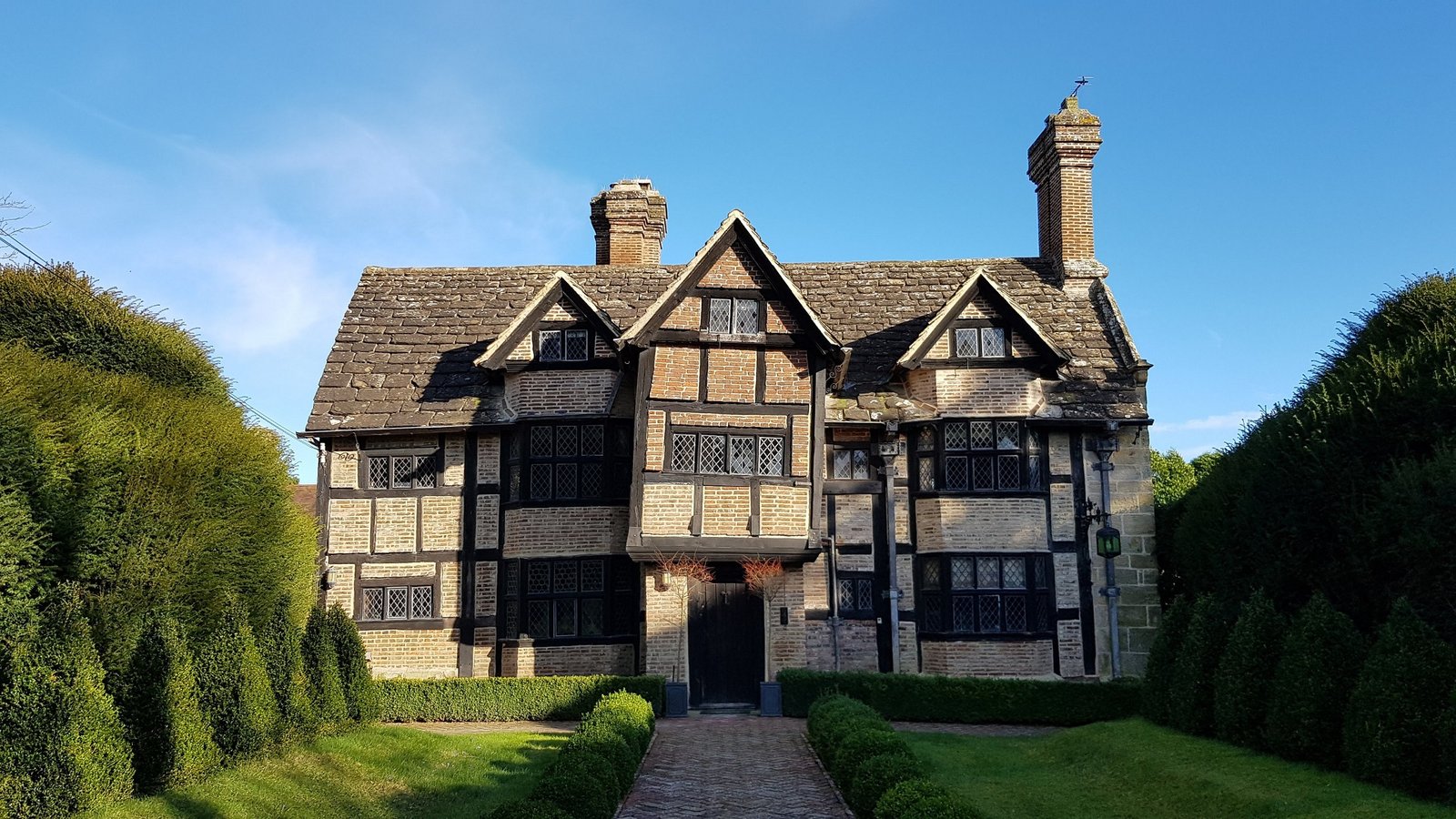

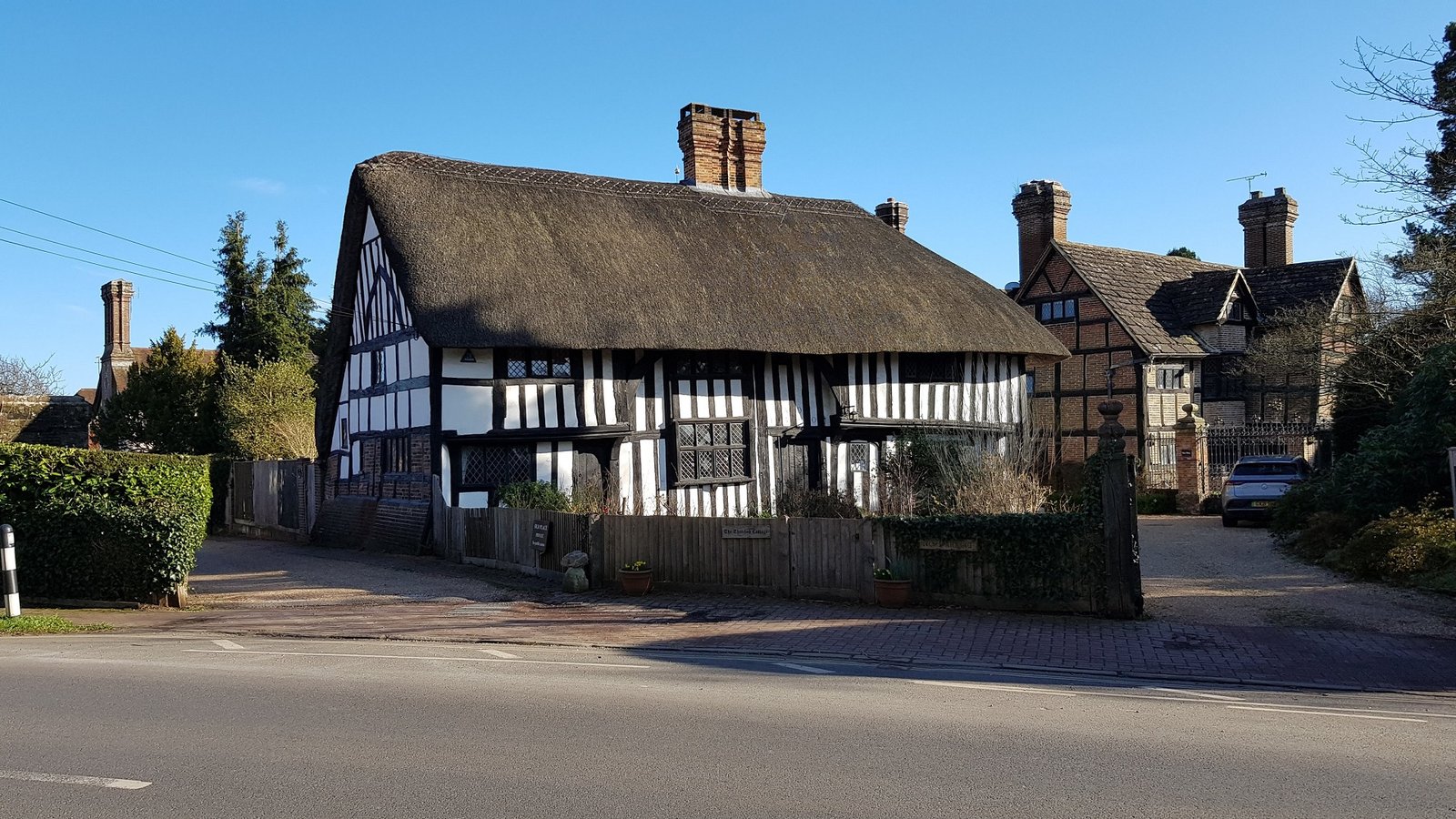

Return down the High Street.
After passing two attractive timber framed houses, Firs Cottage and Little Blacklands, there is an entrance to three sandstone buildings. These were built in 1856 by Revd Francis Sewell as a school and the Master’s neo-gothic house. The school closed after five years and was then used as an evangelical mission hall until the 1930s.

21 Townlands
The house and the farm were purchased in 1813 by Captain John Pilfold RN. In 1805, Pilfold was the First Lieutenant on HMS Ajax. His commanding officer was recalled to London leaving Pilfold in charge of the ship, which then joined the British fleet at Trafalgar playing an active part in securing victory. Pilfold was duly promoted and rewarded.
On taking up residence at Townlands he renamed it ‘Nelson Hall’ and in 1815 set about major alterations, adding the black mathematical tiled Georgian style false front up to the roof line.
In 1823 the house and farm were sold by John Pilford to Francis Smith and his wife Marie Josephine Villeneuve Smith. Both Francis Smith and Marie were born in the Caribbean, and the children of a black mother and white father. Marie Josephine always claimed, but unproven, her father was Pierre Charles Baptiste Silvestre de Villeneuve, a French naval officer stationed in the West Indies. Villeneuve later commanded the French fleet defeated by Nelson at Trafalgar. How ironic if Villeneuve’s illegitimate daughter lived in a house with Trafalgar victory connections. Francis Smith sold the house in 1828 and migrated to Tasmania.

22 Upper High Street – West side.
Walking down the High Street towards Hickmans Lane there is a pleasing mix of mostly medieval or post medieval houses, although their ages are not immediately apparent as many have been re-fronted.
In the 19th century trades undertaken in this part of the High Street, ranged from cordwainers and gaiter makers and tailors to bonnet makers. At the southern end of Wickham House, with its mansard roof, a painted over sign advertised ‘Geo. Mason Fly & Cab Proprietor. Carriages of Every Description for hire’.
On the corner with Hickmans Lane is the old toll cottage for the second turnpike toll gate to prevent evading the High Street gate. High up on the adjoining houses is the remains of a trade sign for Wratten’s, a ‘department store’.
During the 17th and 18th centuries, at this point in the middle of High Street, stood a short row of medieval trade premises, with chamber above the workshop or shop. The nearest to Hickmans Lane junction was a blacksmith’s forge. All had disappeared by the early 1800s.
Please take care crossing Hickmans Lane.
23
Barnlands and Well House
The adjoining Barnlands and Well House, the cross wing, have a fine Horsham stone roof. Barnlands dates from the late 1500s while Well House is older being a medieval cross wing. This indicates it was originally part of an earlier medieval house that became dilapidated and replaced with today’s Barnlands.
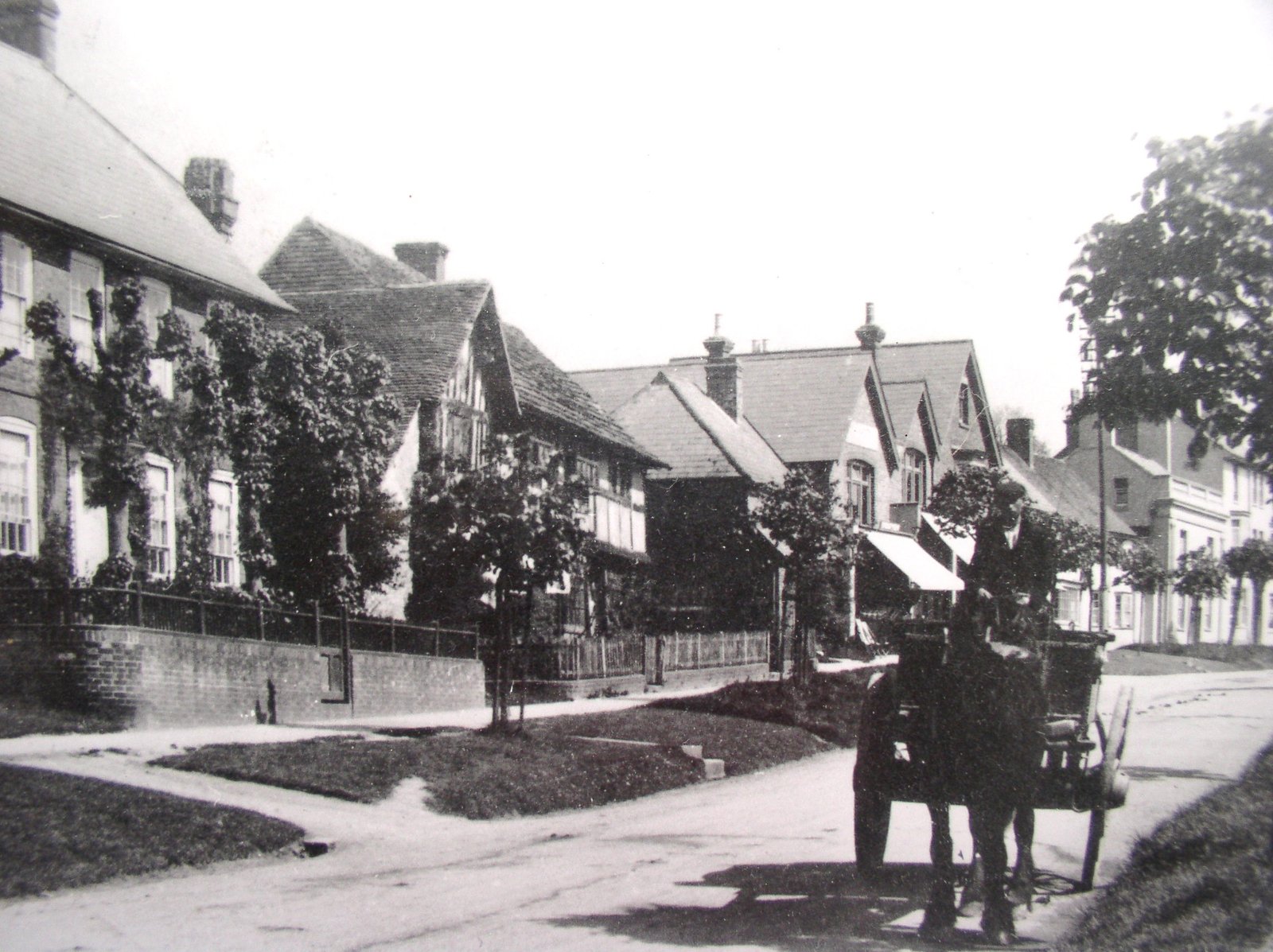


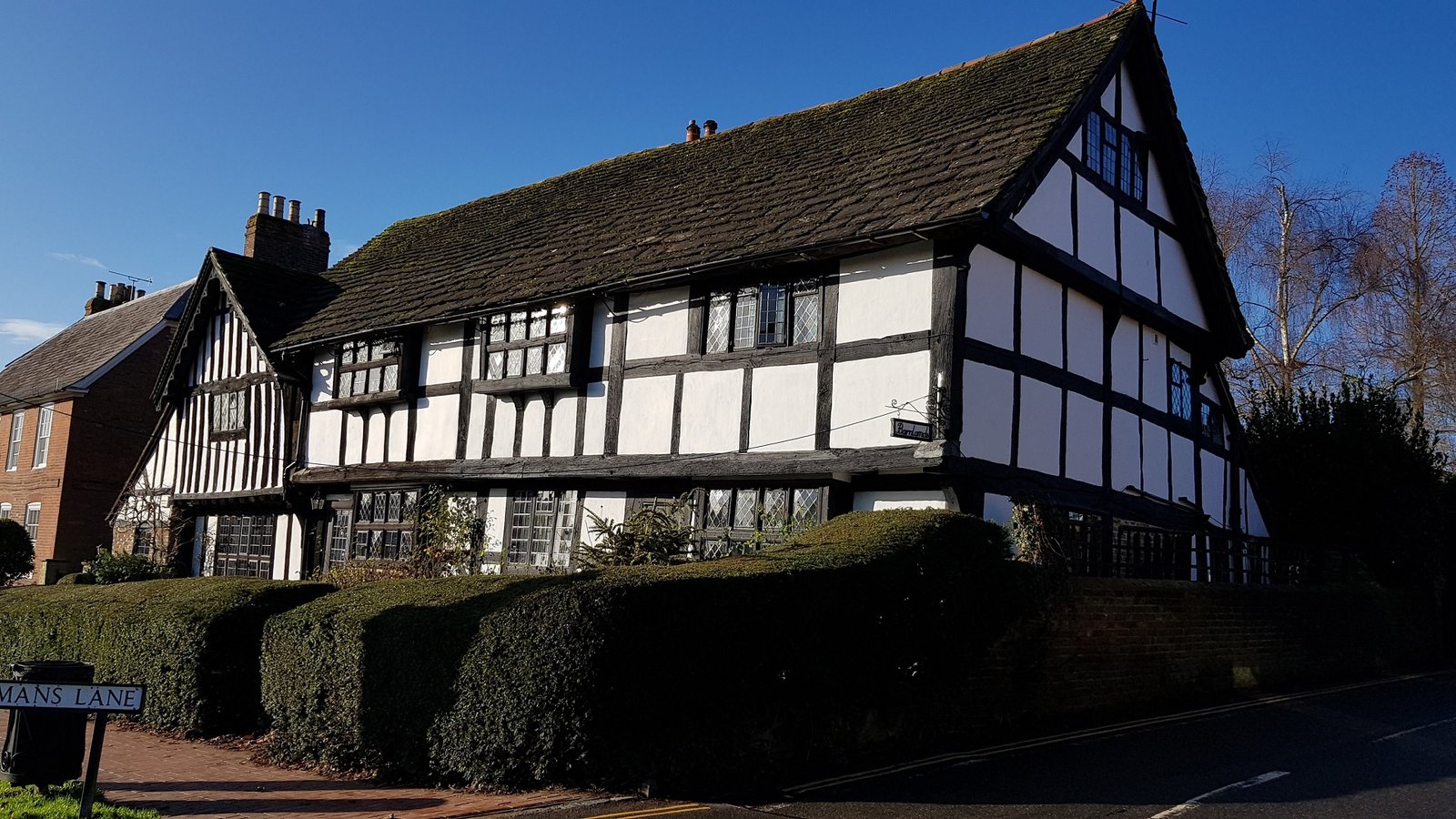
Continue down the High Street, passing Nash House (c1720) with its early Georgian facade.
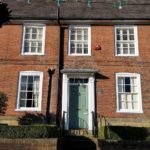
24 Manor House
Although called the Manor House it has never been the home of the Lord of the Manor. The imposing house is another example of being re-fronted, as behind the 18th mathematical tiles is a post-medieval timber framed house, built around 1650.
From 1886 to 1898 it was the home of author George Forrester Scott who, under the name John Halsham wrote, Idlehurst: A Journal kept in the Country. On publication in 1898 it was regarded by critics as a minor classic and is still available today. The book describes the day to day life in a village, called Arnington, a pseudonym for Lindfield. Interestingly he mentioned incoming Londoners and their desire for large villas that ‘spring up like magic’, a feature that was changing the rural character of Lindfield in the late 1800s.
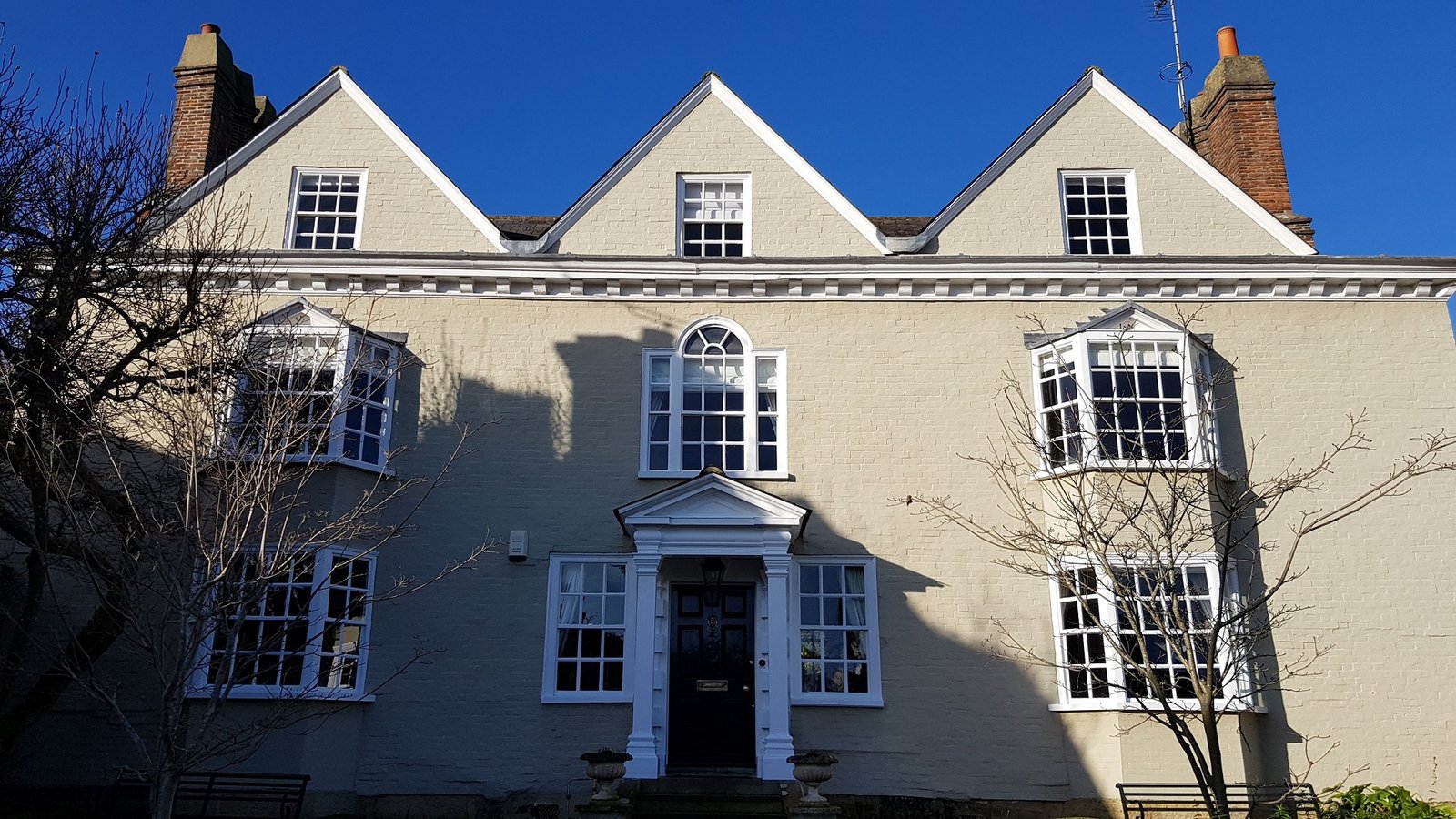
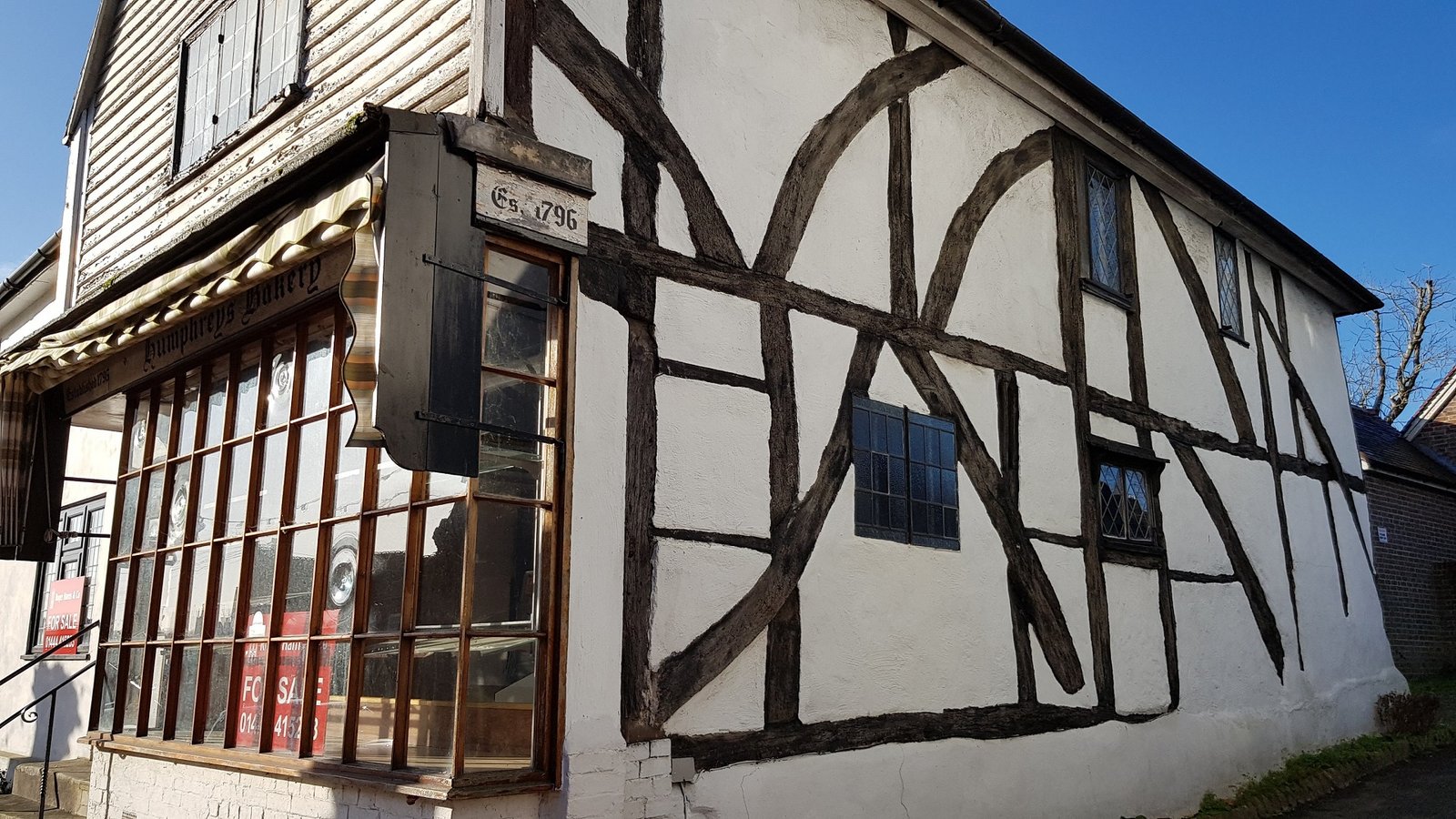
25 no. 65 High Street
Locally known as Humphrey’s, a name derived from past ownership by the family of that name. They were one of four families of bakers that ran a bakery in this building from 1796 to 2019.
Built as the cross wing of a medieval house, it is another of the oldest surviving buildings, dating from the early 1300s. Its age is clearly evidenced by the exposed timber framing at the side.
26 Stand Up Inn
In 1853, John Arnold built five houses and a shop, known as Arnold Terrace. The Stand Up Inn occupied the northernmost house as the beer house of Edward Durrant’s brewery. This stood behind the inn and ceased brewing around 1906.
Now occupying three of the five original houses, the Stand Up name is derived from having no chairs or tables so workers would not linger over their beer.
The High Street at this point is considerably wider as for many centuries it was the site of Lindfield Fair.

We hope you have enjoyed this Jubilee Trail
Continue to browse the shops, cafes and pubs
in Lindfield’s historic and vibrant High Street
ACKNOWLEDGEMENTS & THANKS:
Produced & Edited by: Maxine Tyler & Lindfield Society
Photography by: Lindfield Society
Trail researched & written by: Richard Bryant & Janet Bishop, Lindfield History Project Group
With thanks to artist Brett Hudson who generously gave his time to create the map
Thanks to Andrew Funnell, Clerk to Lindfield Parish Council for his assistance
The Society is grateful to the Trustees of King Edward Hall for allowing the map to be erected on their wall
Thanks go to Hurstpierpoint Society for their inspiration and advice
Thanks to Cathy Hayes, Refresh Designs, who transformed our Brochure, making it look professional
